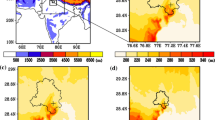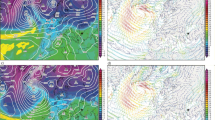Abstract
We evaluate the efficacy of microphysics and planetary-boundary-layer (PBL) parametrizations of the Weather Research and Forecasting (WRF) model for simulation of the coverage and intensity (visibility) of fog during the Coastal Fog (C-FOG) Research Program. The C-FOG observations are used for model validation, particularly focusing on offshore and onshore fog events during 13–14 and 28–29 September 2018. Sensitivity experiments with high horizontal (1 km) and vertical (99 levels) resolution are conducted to elicit possible physical processes underlying the fog life-cycle. Various microphysical and PBL parametrizations, as well as empirical algorithms available for visibility calculations, are evaluated. The model coastal fog formation and characteristics strongly depend on the simulated local meteorology (e.g., temperature, relative humidity, mixing ratio, and wind field) and the microphysical parametrization employed. High space–time resolution simulations for fog coverage and visibility based on the Mansell et al. (J Atmos Sci 67(1):171–194, 2010) microphysical parametrization compare better with data vis-à-vis other microphysical parametrizations, although spatial coverage and visibility are still overestimated. The disparities are likely related to uncertainties of model fog microphysical parameters, including the liquid water content (LWC), droplet number concentration (Nd), and aerosol particle size. It is found that (i) visibility algorithms that use both the variables LWC and Nd, instead of only LWC, provide improved fog estimates; (ii) different PBL parametrizations mainly affect the fog onset and dissipation; (iii) the WRF model has improved performance over the ocean than over land, possibly due to homogeneity of the ocean-surface cover.














Similar content being viewed by others
References
Bang CH, Lee JW, Hong SY (2009) Predictability experiments of fog and visibility in local airports over Korea using the WRF model. J Korean Soc Atmos Environ 24:92–101
Benjamin SG, Weygandt SS, Brown JM, Smith T L, Smirnova T, Moninger WR, Schwartz B (2004) Assimilation of METAR cloud and visibility observations in the RUC. In: 11th conference on aviation, range, aerospace and 22nd conference on severe local storms, Hyannis, MA, Am Meteorol Soc, 9.13
Chen F, Dudhia J (2001) Coupling an advanced land surface–hydrology model with the Penn State–NCAR MM5 modeling system. Part I: model implementation and sensitivity. Mon Wea Rev 129:569–585
Chen C, Zhang M, Perrie W, Chang R, Chen X, Duplessis P, Wheeler M (2020) Boundary layer parameterizations to simulate fog over Atlantic Canada waters. Earth Space Sci 7:e2019EA000703. https://doi.org/10.1029/2019EA000703
Creighton G, Kuchera E, Adams-Selin R, McCormick J, Rentschler S, Wickard B (2014) AFWA Diagnostics in WRF. Accessed 25 June 2020. http://www2.mmm.ucar.edu/wrf/users/docs/AFWA_Diagnostics_in_WRF.pdf
Doran JA, Roohr PJ, Beberwyk DJ, Brooks GR, Gayno GA, Williams RT, Lewis JM, Lefevre RJ (1999) The MM5 at the Air Force Weather Agency—New products to support military operations. In: Proceedings of the 8th Conference on Aviation, Range, and Aerospace Meteorology, NOAA/NWS, Dallas, Texas
Dorman CE, Mejia J, Koracin D, McEvoy D, Koracin D, Dorman CE (2017) Worldwide marine fog occurrence and climatology (Chap. 2). In: Marine fog: Challenges and Advancements in Observations, Modeling, and Forecasting. Springer, New York, USA, pp 7–152
Fernando HJ, Gultepe I, Dorman C, Pardyjak E et al (2021) C-FOG: life of coastal fog. BAMS. https://doi.org/10.1175/BAMS-D-19-0070.1
Grachev A, Krishnamurthy R, Fernando HJS, Fairall C, Bardoel S, Wang S (2021) Atmospheric Turbulence Measurements in Coastal Zone with and without Fog. Boundary-Layer Meteorol, special issue. https://doi.org/10.1007/s10546-021-00655-9
Gultepe I, Müller MD, Boybeyi Z (2006) A new warm fog parameterization scheme for numerical weather prediction models. J Appl Meteorol 45:1469–1480
Gultepe I, Tardif R, Michaelides SC, Cermak J, Bott A, Bendix J, Müller M, Pagowski M, Hansen B, Ellrod G, Jacobs W, Toth G, Cober SG (2007a) Fog research: a review of past achievements and future perspectives. Pure Appl Geophys 164:1121–1159
Gultepe I, Pagowski M, Reid J (2007b) A satellite-based fog detection scheme using screen air temperature. Weather Forecast 22(3):444–456
Gultepe I, Pearson G, Milbrandt JA, Hansen B, Platnick S, Taylor P, Gordon M, Oakley JP, Cober SG (2009) The fog remote sensing and modeling field project. Bull Am Meteorol Soc 90:341–359
Gultepe I, Zhou B, Milbrandt J, Bott A, Li Y, Heymsfield A, Ferrier B, Ware R, Pavolonis M, Kuhn T, Gurka J, Liu P, Cermak J (2015) A review on ice fog measurements and modeling. Atmos Res 151:2–19
Gultepe I, Pardyjak E, Hoch SW, Fernando HJS, Dorman C, Flagg D, Krishnamurthy R, Wang Q, Gaberšek S, Creegan E, Scantland N, Desjardins S, Heidinger A, Pavolonis M, Heymsfield AJ (2021) Coastal fog microphysics using in-situ observations and GOES-R retrievals. Submitted to Boundary-Layer Meteorol special issue
Hong SY, Noh Y, Dudhia J (2006) A new vertical diffusion package with an explicit treatment of entrainment processes. Mon Weather Rev 134:2318–2341
Iacono MJ, Delamere JS, Mlawer EJ, Shephard MW, Clough SA, Collins WD (2008) Radiative forcing by long-lived greenhouse gases: calculations with the AER radiative transfer models. J Geophys Res Atmos 113:2–9
Kain JS (2004) The Kain-Fritsch convective parameterization: an update. J Appl Meteorol 43:170–181
Lin C, Zhang Z, Pu Z, Wang F (2017) Numerical simulations of an advection fog event over Shanghai Pudong International Airport with the WRF model. J Meteorol Res 31(5):874–889
Mansell ER, Ziegler CL, Bruning EC (2010) Simulated electrification of a small thunderstorm with two-moment bulk microphysics. J Atmos Sci 67(1):171–194
Mansell ER, Ziegler CL (2013) Aerosol effects on simulated storm electrification and precipitation in a two-moment bulk microphysics model. J Atmos Sci 70(7):2032–2050
Maronga B, Bosveld FC (2017) Key parameters for the life cycle of nocturnal radiation fog: a comprehensive large-eddy simulation study. Q J R Meteorol Soc 143:2463–2480
Milbrandt JA, Yau MK (2005) A multimoment bulk microphysics parameterization. Part I: analysis of the role of the spectral shape parameter. J Atmos Sci 62(9):3051–3064
Morrison H, Curry JA, Khvorostyanov VI (2005) A new double-moment microphysics parameterization for application in clouds and climate models. Part I: description. J Atmos Sci 62:1665–1677
Nakanishi M, Niino H (2006) An improved Mellor-Yamada level-3 model: its numerical stability and application to a regional prediction of advection fog. Boundary-Layer Meteorol 119:397–407
Petterssen S (1940) Weather analysis and forecasting: a textbook on synoptic meteorology. McGraw-Hill, New York, p 506
Pithani P, Ghude SD, Chennu VN, Kulkarni RG, Steeneveld GJ, Sharma A, Prabhakaran T, Chate DM, Gultepe I, Jenamani RK, Madhavan R (2019) WRF model prediction of a dense fog event occurred during the winter fog experiment (WIFEX). Pure Appl Geophys 176(4):1827–1846
Pollard R, Rhines P, Thompson R (1972) The deepening of the wind-mixed layer. Geophys Fluid Dyn 4(4):381–404
Price J (2011) Radiation fog. Part I: observations of stability and drop size distributions. Boundary-Layer Meteorol 139:167–191
Song JI, Yum SS, Gultepe I, Chang KH, Kim BG (2019) Development of a new visibility parameterization based on the measurement of fog microphysics at a mountain site in Korea. Atmos Res 229:115–126
Skamarock W C, Klemp JB, Dudhia J., et al. (2008) A Description of the Advanced Research WRF Version 3. NCAR Tech Rep, NCAR/TN-475+STR
Sharma A, Dimitrova R, Fernando HJS, Wang S, Wagh SD (2019) High resolution numerical simulations of advection fog events during C-FOG field campaign. In: Proceedings of the AGU fall meeting, 9–13 December 2019, San Francisco, USA, A33R-2979
Stoelinga MT, Warner TT (1999) Nonhydrostatic, mesobeta-scale model simulations of cloud ceiling and visibility for an East Coast winter precipitation event. J Appl Meteorol 38:385–404
Tardif R, Rasmussen RM (2007) Event-based climatology and typology of fog in the New York City region. J Appl Meteorol Climatol 46:1141–1168
Thompson G, Field PR, Rasmussen RM, Hall WD (2008) Explicit forecasts of winter precipitation using an improved bulk microphysics scheme. Part II: implementation of a new snow parameterization. Mon Weather Rev 136:5095–5115
Toth G, Gultepe I, Milbrandt J, Hansen B, Pearson G, Fogarty C. et al. (2011) The environment Canada handbook on fog and fog forecasting. Environment Canada. Tech Manual ISBN # 978–1–100–52518–1. Available from Environment Canada, Toronto, Canada
Twomey S (1959) The nuclei of natural cloud formation part II: the supersaturation in natural clouds and the variation of cloud droplet concentration. Geofis Pura Appl 43:243–249
User's Guide for the NCEP Unified Post Processor (UPP) Version 3, Accessed 25 June 2020 at https://dtcenter.org/community-code/unified-post-processor-upp
Van der Velde IR, Steeneveld GJ, Schreur BGJW, Holtskag AAM (2010) Modeling and forecasting the onset and duration of severe radiation fog under frost conditions. Mon Weather Rev 138(11):4237–4253
Wagh S, Krishnamurthy R, Wainwright C, Wang S, Dorman C, Fernando HJS, Gultepe I (2021) Microphysics of marine fog formed by stratus lowering. Submitted to BLM special issue
Zhang X, Genon LM, Dupont E, Milliez M, Carissimo B (2014) On the influence of a simple microphysics parameterization on radiation fog modelling: a case study during ParisFog. Boundary-Layer Meteorol 151:293–315
Acknowledgements
This research was funded by the Office of Naval Research Award # N00014-18-1-2472, entitled: Toward Improving Coastal Fog Prediction (C-FOG). Ashish Sharma acknowledges the support of the Prairie Research Institute in the University of Illinois in Urbana-Champaign.
Author information
Authors and Affiliations
Corresponding author
Additional information
Publisher's Note
Springer Nature remains neutral with regard to jurisdictional claims in published maps and institutional affiliations.
Supplementary Information
Below is the link to the electronic supplementary material.
Rights and permissions
About this article
Cite this article
Dimitrova, R., Sharma, A., Fernando, H.J.S. et al. Simulations of Coastal Fog in the Canadian Atlantic with the Weather Research and Forecasting Model. Boundary-Layer Meteorol 181, 443–472 (2021). https://doi.org/10.1007/s10546-021-00662-w
Received:
Accepted:
Published:
Issue Date:
DOI: https://doi.org/10.1007/s10546-021-00662-w




